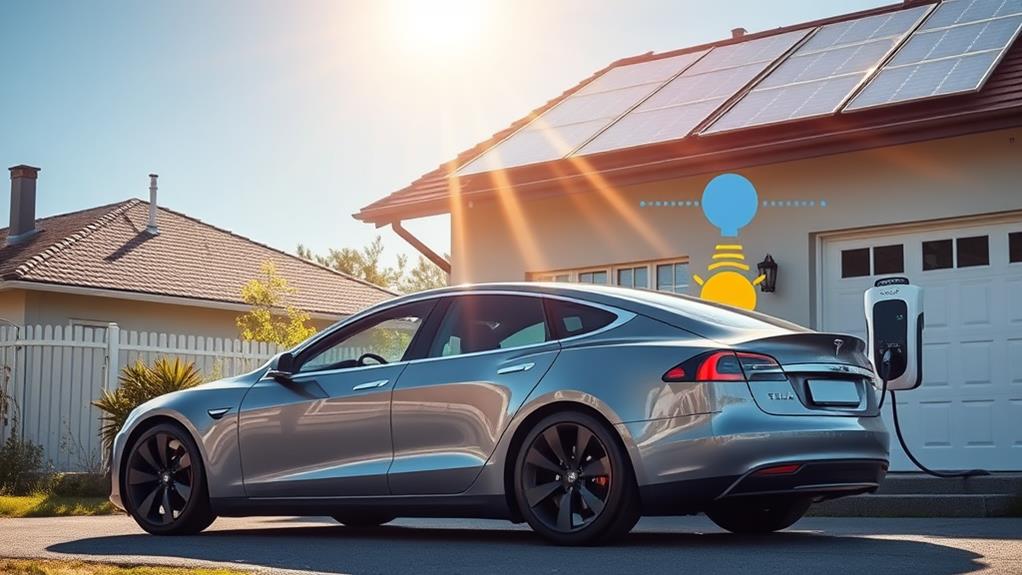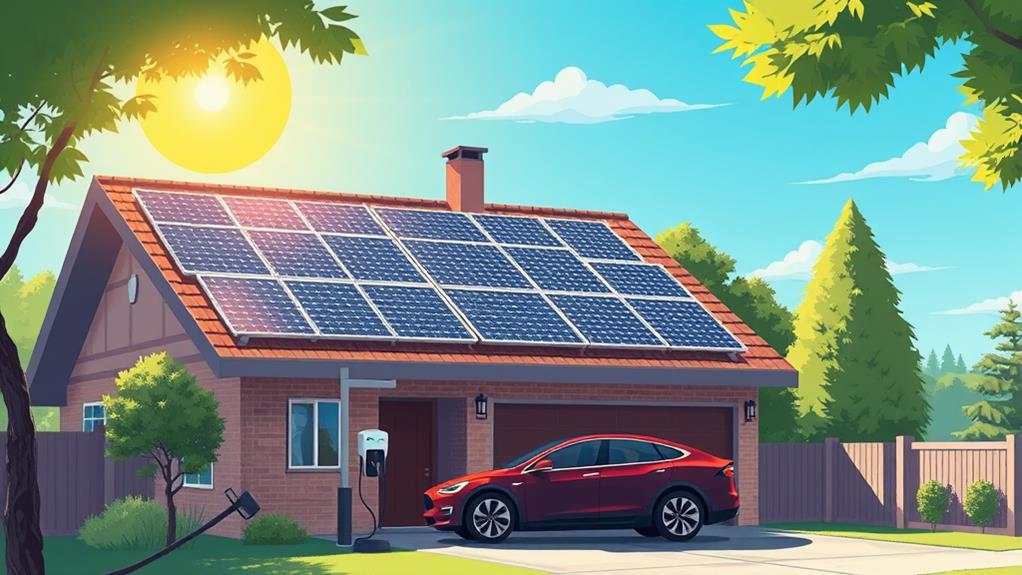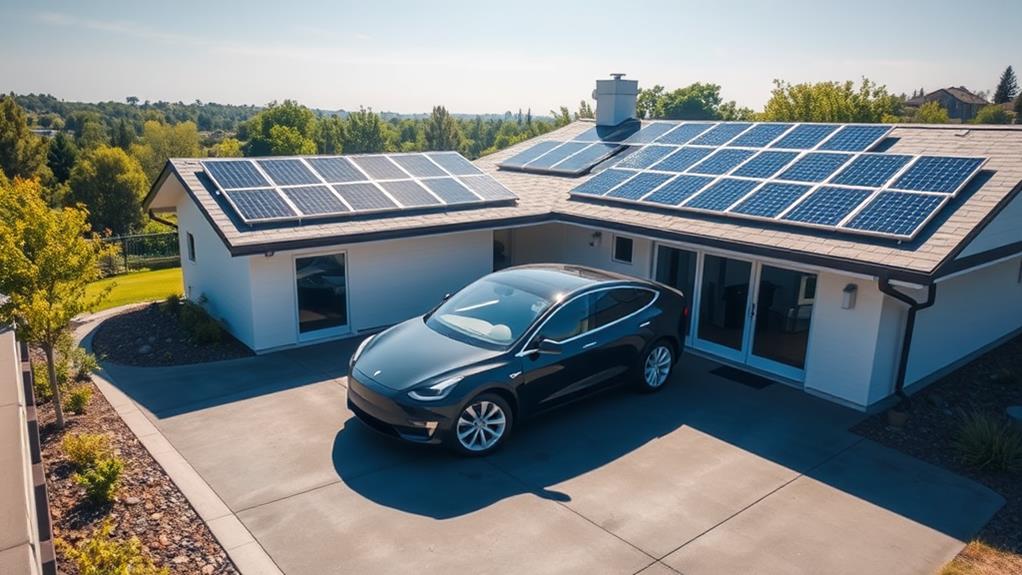When you're figuring out how many solar panels it takes to charge a Tesla, you'll need to start by looking at the battery capacity, which can range from 50 to 100 kWh depending on the model. For example, a Tesla Model 3 with a 75 kWh battery needs around 75 kWh for a full charge. But here's the catch: your daily driving habits and the efficiency of your solar panels play a big role in this calculation. So, how do you accurately estimate the number of panels required to meet your energy needs? Let's explore the factors that will guide you.
Understanding Tesla's Energy Needs

To determine the number of solar panels required to charge a Tesla, it's crucial to first understand the vehicle's energy needs. You need to evaluate the battery capacity and the charging requirements. Tesla models typically have battery capacities ranging from 50 kWh to 100 kWh. This capacity indicates how much energy the battery can store, which directly impacts the amount of electricity required for a full charge.
Additionally, the efficiency of your solar panels and proper inverter selection can considerably affect the overall system performance.
Next, assess the charging requirements. A Tesla Model 3, for example, with a 75 kWh battery, needs 75 kWh of electricity for a full charge. To harness this energy from solar panels, you'll need to calculate their output.
Standard solar panels produce around 300 watts per hour under ideal conditions. Consequently, you'll need to determine the total kWh generated by your solar panels over a given period, typically daily, to match the Tesla's battery capacity.
Calculating Your Daily Driving Range
Understanding your daily driving range is vital for accurately calculating the number of solar panels needed to charge your Tesla. Start by analyzing your driving habits. Keep a log of your daily mileage over a typical week to establish an average. This average will help you understand how much energy you consume daily. Additionally, consider the benefits of solar power systems for residential homes, which can greatly reduce electricity costs.
Next, consider your Tesla's battery capacity. Different models have varying capacities, typically ranging from 50 kWh to 100 kWh. Knowing your vehicle's capacity allows you to calculate the energy required to replenish the battery based on your daily usage. For example, if you drive 30 miles daily and your Tesla consumes 0.3 kWh per mile, you'd need 9 kWh of energy each day.
Once you've determined your daily energy needs, you can convert this requirement into the number of solar panels needed. However, for now, focus on accurately understanding your daily driving range and the corresponding energy consumption.
This calculation is a vital step towards achieving the freedom of powering your Tesla sustainably with solar energy. By analyzing your driving habits and knowing your battery capacity, you're one step closer to energy independence.
Solar Panel Efficiency Factors

When considering solar panel efficiency, you need to account for variability in sunlight exposure and panel conversion rates.
Sunlight availability fluctuates based on geographic location, weather conditions, and time of year. Advanced technologies can help enhance the efficiency in energy conversion despite these variables.
Additionally, the efficiency of solar panels in converting sunlight to electricity directly impacts how many panels you'll need to charge your Tesla.
Sunlight Exposure Variability
Sunlight exposure variability plays an essential role in determining the efficiency of solar panels. Sunlight intensity fluctuates based on your geographical location and the time of year, affecting how much energy your panels can generate.
Seasonal changes further impact sunlight availability; for instance, winter months might offer fewer daylight hours and lower sunlight intensity compared to summer.
Weather patterns also influence solar efficiency. Cloud coverage can notably reduce the amount of sunlight that reaches your panels, thereby lowering their output. Additionally, shading effects from nearby buildings or trees can create obstructions, which reduce the total energy captured by your solar panels.
Panel orientation is another vital factor. Panels facing the best direction for your specific location will maximize exposure to sunlight, thereby enhancing efficiency. Misaligned panels can miss out on the full potential of the available sunlight, especially during peak sunlight hours.
Understanding these variables allows you to enhance your solar array's placement and configuration, ensuring you harness the maximum amount of energy possible.
In doing so, you gain the freedom to rely less on the grid and more on sustainable energy to charge your Tesla, aligning with your desire for autonomy and environmental responsibility.
Panel Conversion Rates
Panel conversion rates, often referred to as solar panel efficiency factors, are critical for determining how effectively a solar panel converts sunlight into usable electricity. When considering different panel types, you'll find variations in efficiency that can greatly impact your energy output.
Monocrystalline panels, for example, typically offer higher efficiency rates, around 15-20%, compared to polycrystalline panels, which range from 13-16%.
Understanding these differences is essential because higher efficiency panels can generate more electricity in less space, potentially lowering your installation costs. However, they tend to be more expensive upfront. So, it's a trade-off between higher initial investment and long-term energy savings.
Moreover, panel types and their respective efficiencies directly affect how many panels you'll need to charge your Tesla. A higher conversion rate means fewer panels are required to meet your energy demands.
Calculating the total energy output involves multiplying the panel's efficiency by the sunlight exposure time and the panel's surface area. Always consider installation costs, as more efficient panels might reduce overall expenses by minimizing the number of panels and installation labor required.
This approach allows you to maximize efficiency while maintaining financial freedom.
Estimating Solar Panel Output
Understanding the output of solar panels is essential for determining their effectiveness in charging a Tesla. You need to assess different solar panel types and their respective energy outputs. Common types include monocrystalline, polycrystalline, and thin-film panels. Monocrystalline panels typically offer the highest efficiency, converting more sunlight into electricity per square foot. Polycrystalline panels are slightly less efficient but more cost-effective. Thin-film panels, while flexible and lightweight, generally provide the lowest efficiency.
To estimate solar panel output, consider the wattage rating provided by the manufacturer, which usually ranges from 250 to 400 watts per panel. Multiply this by the average number of sunlight hours your location receives daily. For instance, if you have a 300-watt panel and your area gets five hours of sunlight, each panel generates 1,500 watt-hours (1.5 kWh) per day.
Additionally, factors such as solar irradiance and spectral distribution can influence the actual energy output considerably.
Energy storage is another critical factor. You'll need a battery system capable of storing excess energy generated during peak sunlight hours for use when sunlight is unavailable. This guarantees a steady supply of power to charge your Tesla effectively.
Real-World Examples

By examining real-world examples, you can better grasp how solar panels perform in various scenarios for charging a Tesla. Real life scenarios offer invaluable insights into the practicality and efficiency of different charging options. Here are four illustrative examples:
1. Urban Environment: In a city setting, a Tesla owner with limited roof space installs 10 high-efficiency panels. These panels generate around 3,500 kWh annually, enough for approximately 10,000 miles of driving.
For those needing installation services in an urban area, MCS accredited professionals guarantee quality results.
2. Suburban Environment: A suburban homeowner with ample roof space installs 20 standard panels, producing 7,000 kWh per year. This setup comfortably covers both home energy needs and up to 20,000 miles of Tesla driving annually.
3. Rural Environment: In a rural area with abundant sunlight, a Tesla driver installs 25 premium panels. These panels generate 10,000 kWh per year, allowing for extensive driving of up to 30,000 miles and powering a home.
4. Off-Grid Scenario: An off-grid enthusiast installs 30 ultra-efficient panels coupled with a battery storage system. This configuration produces and stores 12,000 kWh annually, guaranteeing reliable vehicle charging and home energy independence even in remote areas.
These examples demonstrate how different charging options can be tailored to fit your specific needs and environment, maximizing your freedom and independence.
Additional Considerations
When planning to charge your Tesla with solar panels, it's crucial to take into account several additional factors that can impact the efficiency and feasibility of your setup.
First, consider battery storage; having a battery system allows you to store excess energy generated during the day for use at night or during cloudy periods.
Installation costs are another critical element. These can vary based on system size and complexity, so get multiple quotes to confirm you're getting a fair price.
Don't forget to check for energy incentives, as federal or state programs may offset some of these expenses.
A grid connection provides a backup power source if your solar generation falls short. Make certain your setup is compatible with local grid requirements and regulations.
Maintenance requirements, such as cleaning panels and checking for wear, also affect long-term performance.
Your location's impact can't be overlooked. Geographic factors like average sunlight hours and weather patterns will influence how many panels you need.
Lastly, consider the various charging options available, such as Level 1 or Level 2 chargers, to determine the most efficient way to power your Tesla.
Conclusion
To charge your Tesla efficiently, you need to understand your energy needs, calculate your daily driving range, and consider solar panel efficiency. Estimating solar panel output helps you determine the exact number you'll require. By analyzing real-world examples and additional considerations, you'll make an informed decision. Balancing these factors guarantees your Tesla is charged, your costs are optimized, and your environmental impact is minimized. Accurate planning, precise calculations, and thoughtful execution are key.
